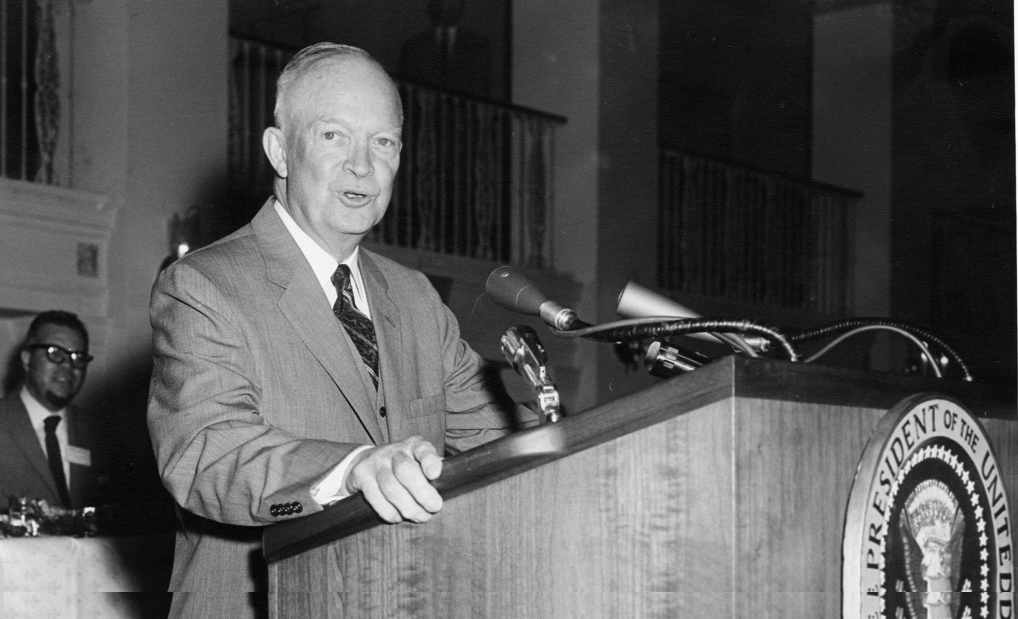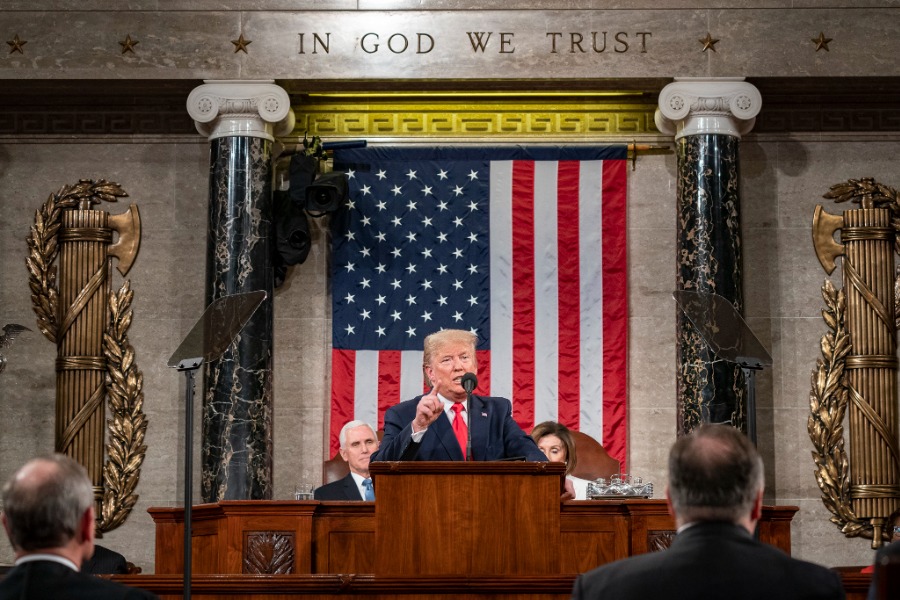Remembering Eisenhower’s Formosa AUMF
On this date in 1955, President Dwight Eisenhower signed a congressional joint resolution authorizing military force to protect Formosa, as Taiwan was then called by the U.S. government, and surrounding islands. It’s one of the most interesting force authorizations in American history: It reflected Eisenhower’s complicated ambivalence toward constitutional powers, it was open-ended, it contemplated the possible use of nuclear weapons, and it was never actually invoked.

Published by The Lawfare Institute
in Cooperation With

On this date in 1955, President Dwight Eisenhower signed a congressional joint resolution authorizing military force to protect Formosa, as Taiwan was then called by the U.S. government, and surrounding islands. It’s one of the most interesting force authorizations in American history: It reflected Eisenhower’s complicated ambivalence toward constitutional powers, it was open-ended, it contemplated the possible use of nuclear weapons, and it was never actually invoked. It’s especially worth remembering this episode now, as President Trump calls into question the U.S.’s alliance commitments and American rivals test them.
When Eisenhower took office in 1953, his security strategy emphasized firm defense commitments to overseas allies that balanced against the Communist Soviet Union and China. It also emphasized taming runaway defense spending. To reconcile these seemingly conflicting tenets, Eisenhower relied on the threat of massive retaliation—including nuclear weapons—against aggression.
This approach was put to a major test in late 1954 and early 1955, when Communist China shelled tiny coastal islands that were under control of U.S.-allied Nationalist China, based in what we now call Taiwan. The United States had at this point signed, but not yet ratified, a mutual-defense treaty with Nationalist China. Not wanting war but concerned about appearing weak and unreliable in the face of communist assaults, the Eisenhower administration engaged in brinkmanship.
To help deter Communist China and reassure the Nationalist Chinese leadership, in late January 1955, Eisenhower went to Congress for authorization to use force. “Communist China has pursued a series of provocative political and military actions, establishing a pattern of aggressive purpose,” Eisenhower declared in his message to Congress. The situation had become sufficiently dire, he continued, to demand congressional authorization for “the use of the armed forces of the United States if necessary to assure the security of Formosa and the Pescadores.”
Days later, Congress obliged by nearly unanimous votes in both houses. The resulting joint resolution delegated vast discretion to the president to use force:
Resolved by the Senate and House of Representatives of the United States of America in Congress assembled, That the President of the United States be and he hereby is authorized to employ the Armed Forces of the United States as he deems necessary for the specific purpose of securing and protecting Formosa, and the Pescadores against armed attack, this authority to include the securing and protection of such related positions and territories of that area now in friendly hands and the taking of such other measures as he judges to be required or appropriate in assuring the defense of Formosa and the Pescadores.
This resolution shall expire when the President shall determine that the peace and security of the area is reasonably assured by international conditions created by action of the United States or otherwise, and shall so report to the Congress.
In the next couple of months, as tensions simmered, Eisenhower signaled the possibility of major military action—even publicly referencing nuclear options. But cooler heads prevailed, and all sides soon stepped back from the brink. Several years later, shelling and skirmishing between Communist and Nationalist China resumed, but the conflict did not escalate. There has been a lot of debate about how effective Eisenhower’s threats really were, including their unintended consequences.
One important aspect of the 1955 force resolution is the vast discretion it granted the president. It authorized in advance whatever force the president deemed necessary to protect a far-flung ally. Multiple times it emphasized the president’s role as sole judge of necessity. And its duration was open-ended. Congress eventually repealed it—20 years later. (And if that authorization seems broad, stay tuned for my essay in March about the 1957 Middle East force authorization that Eisenhower requested and Congress approved, which still remains on the books today.)
Another important aspect of the resolution is how it fudged the constitutional allocation of power, in a way that is now common. Some scholars credit Eisenhower with commitment to congressional primacy on war-making and resistance to presidential aggrandizement. The story is more complicated than that, though. True, in this crisis, and two years later in announcing an interventionist doctrine toward Middle East security, Eisenhower went to Congress for an authorization to use force. A year before the Formosa crisis, he also said he wouldn’t intervene in Indochina, now Vietnam, without congressional approval. But Eisenhower was conflicted on the issue of constitutional war powers, and his security strategy sometimes pulled in different directions than his constitutional principles. Despite his belief in congressional control over decisions to go to war, in the end his administration did a lot to fortify the post-WWII expansion of presidential authority.
In internal discussions months before he went to Congress for the Formosa resolution, Eisenhower and his cabinet had expressed concern about the constitutionality of intervening militarily without congressional approval, since American military strikes could well escalate into a major conflict. According to a memo of those deliberations: “The President said that [to launch strikes against Communist China] you would have to get Congressional authorization, since it would be war. If Congressional authorization were not obtained there would be logical grounds for impeachment.” In a subsequent meeting days before requesting the congressional authorization, Eisenhower stated “that he would do in an emergency whatever had to be done to protect the vital interests of the United States. He would do this even if his actions should be interpreted as acts of war. He would rather be impeached than fail to do his duty.” Interestingly, Eisenhower reported in that same meeting that in consulting congressional leaders, House Speaker Sam Rayburn “had said that the President had all the powers he needed to deal with the situation,” and Rayburn even believed “that a joint resolution at this particular moment would be unwise because the President would be saying in effect that he did not have the power to act instantly.”
Despite Eisenhower’s own doubts about presidential war powers, when he requested publicly that Congress authorize force, he stated that:
Authority for some of the actions which might be required would be inherent in the authority of the Commander-in-Chief. Until Congress can act I would not hesitate, so far as my Constitutional powers extend, to take whatever emergency action might be forced upon us in order to protect the rights and security of the United States.
Exactly how far that unilateral authority extended was kept deliberately vague. Moreover, rather than acknowledging any constitutional necessity for congressional authorization, Eisenhower publicly emphasized only that congressional action would eliminate doubt about his powers and strengthen the potency of deterrent threats toward foreign adversaries:
[A] suitable Congressional resolution would clearly and publicly establish the authority of the President as Commander-in-Chief to employ the armed forces of this nation promptly and effectively for the purposes indicated if in his judgment it became necessary. It would make clear the unified and serious intentions of our Government, our Congress and our people.
Eisenhower got more pushback from Congress on the grounds that its authorization was unnecessary than that it was too broad and open-ended.
In many ways, the Formosa resolution provided a model for the now-infamous Gulf of Tonkin Resolution a decade later. Like so many presidents to follow, LBJ requested the congressional force authorization without yielding his position that he already had constitutional authority. Both resolutions authorized force to deal with a regional threat without actually naming in law the specific enemy. There is some irony that the Gulf of Tonkin Resolution is today so much better remembered than the Formosa resolution, since LBJ confidently expected North Vietnam to back down in the face of limited air strikes whereas Eisenhower contemplated from the start at least the possibility of going nuclear. Since Eisenhower, it has been common practice for presidents seeking congressional authorization for the use of force to reserve carefully their unilateral power to act regardless. (See, for example, Obama’s 2013 request for congressional authorization to strike Syria, while noting “I believe I have the authority to carry out this military action without specific congressional authorization.”)
Usually, presidents have requested force authorizations because the president either has initiated force already or plans to do so. But a final important aspect of the Formosa force resolution is that it was never invoked. Eisenhower held the resolution in his pocket but didn’t launch strikes, even when Communist China’s shelling of Chinese Nationalist forces later resumed. That’s not to say that the resolution was never used, though. Eisenhower’s strategy was one of deterrence, and he expected the congressional resolution to bolster the credibility of his threats. This force resolution’s purpose was more about signaling than warfighting.
Scholars of constitutional war powers tend to look at actual wars, but if we want to understand how effectively they operate, we should be focusing at least as much on wars that didn’t happen. In an article titled “The Power To Threaten War,” I argued that debates about presidential powers to make war overshadow the president’s vast power to threaten war—and yet threatening war is often a key determinant in outbreaks of war or periods of peace. Eisenhower did more than any other president to dial up the role of threatened force in American foreign policy, and as the 1955 force resolution episode shows, he regarded formal interbranch collaboration as important to successfully implementing that strategy.




.jpg?sfvrsn=6cdd11de_5)
